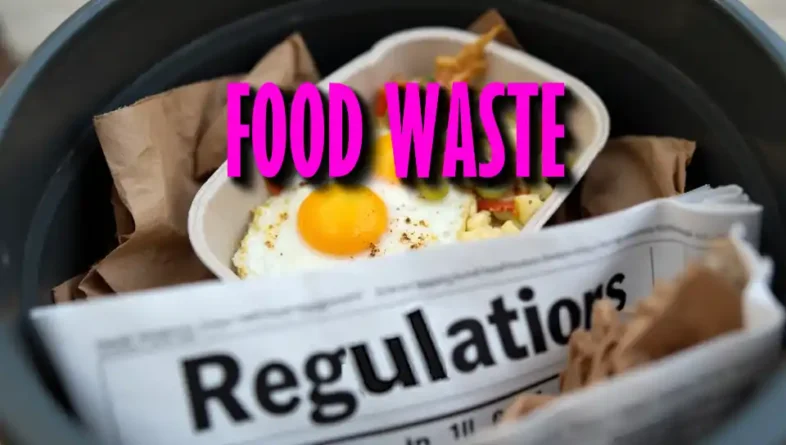An Introduction to Rules and Regulations Regarding Food Waste
One common approach taken by governments is the establishment of targets and goals for reducing food waste. These targets often include specific reduction percentages to be achieved within a certain timeframe. For example, the European Union has set a target to reduce food waste by 50% by 2030, while countries like France and Italy have implemented laws that prohibit supermarkets from throwing away unsold food.
Food waste is a global crisis affecting our economy, environment, and social fabric. Understanding its nuances can empower us to make impactful changes.
What You Will Learn
- Food waste results in significant economic losses, impacting farmers, businesses, and consumers with higher prices and reduced income.
- Wasted food contributes to a substantial environmental footprint, including resource depletion and pollution that exacerbates climate change.
- Policies such as binding targets in the European Union and food donation laws in France and Italy are essential in the fight against food waste.
- Establishing specific food waste reduction targets with realistic timeframes promotes accountability and helps track progress effectively.
- Tax incentives and liability protections for food donors encourage businesses to contribute surplus food to those in need.
- Public awareness campaigns and practical consumer education can significantly reduce food waste through informed behaviors.
- Collaboration among governments, businesses, and non-profits is crucial in addressing food waste on a systemic level.
- Individual actions, like planning meals and volunteering at food banks, can collectively make a difference in reducing food waste.
Understanding the Global Challenge of Food Waste
The Scope and Impact of Food Waste on Society
Economic Consequences of Food Waste
Food waste has significant economic effects. Each year, millions of dollars are lost due to discarded food. This impacts farmers, businesses, and consumers alike, leading to higher prices and reduced income.
Environmental Implications of Wasted Resources
When food is wasted, so are the resources used to produce it. This includes water, land, and energy. The environmental footprint of food waste is staggering, contributing to pollution and climate change.
Social Issues Arising from Food Insecurity
Food waste and food insecurity are interconnected issues. While millions of tons of food are wasted, many people go hungry. This gap highlights a failure in our food systems that needs urgent attention.
Policies and Regulations Shaping Food Waste Management
Global Initiatives and Agreements to Combat Food Waste
The Role of the Food and Agriculture Organization
The Food and Agriculture Organization (FAO) plays a critical role in addressing food waste globally. They promote sustainable practices and provide guidelines to help countries reduce waste. Their efforts aim to create a more efficient food system.
Case Studies: European Union, France, and Italy
Several regions are leading the way in food waste initiatives:
- European Union: Set binding targets for food waste reduction.
- France: Banned food waste in supermarkets, promoting donations.
- Italy: Implemented laws to encourage food redistribution.

Setting Targets: Goals for Reducing Food Waste
Defining Specific Reduction Percentages
Establishing clear reduction goals is essential for progress. Many regions aim to cut food waste by specific percentages over set timelines. These targets help guide actions and measure success.
Establishing Timeframes for Achieving Goals
It’s important to set realistic timeframes for food waste reduction. These timeframes can vary, but having a deadline ensures accountability. Regular assessments can help in modifying strategies as needed.
Regulatory Frameworks and Business Compliance
Mandatory Measurement and Reporting of Food Waste
Businesses are increasingly required to measure and report their food waste. This transparency helps identify areas for improvement. By tracking waste, companies can implement better practices.
Incentives and Penalties for Food Businesses
To encourage compliance, some regions offer incentives or impose penalties:
- Incentives: Tax breaks for reducing waste.
- Penalties: Fines for excessive waste generation.
Innovative Solutions and Community Engagement in Food Waste Reduction
Donation and Redistribution Programs
Tax Incentives for Donating Surplus Food
Many countries are starting to offer tax incentives for businesses that choose to donate their excess food. These incentives can help offset some of the costs associated with food donation, making it a more appealing option for businesses. By encouraging donations, we can aid those in need while also reducing the amount of food that ends up in landfills.
Liability Protections for Donors: Encouraging Generosity
To promote food donation, many regions have implemented liability protections for donors. These laws protect organizations and individuals from being held responsible if the food they donate causes someone to become ill. Knowing they won’t face legal repercussions encourages more businesses to donate their surplus food.
Public Awareness Campaigns and Educational Initiatives
Strategies for Raising Awareness about Food Waste
Public awareness is crucial in fighting food waste. Here are some effective strategies:
- Social Media Campaigns: Utilize platforms like Facebook and Instagram to share tips and facts about food waste.
- Community Events: Host events that educate the public on how to reduce waste.
- Partnerships: Work with local schools and organizations to spread the message.
Empowering Consumers with Practical Tips
Educating consumers about food waste can lead to significant changes in behavior. Here are some practical tips to consider:
- Plan Meals: Create a weekly meal plan to avoid buying unnecessary items.
- Proper Storage: Learn how to store food correctly to extend its shelf life.
- Understanding Labels: Know the difference between “sell by,” “use by,” and “best before” dates.
Fostering Collaboration for Lasting Change
Stakeholders in the Fight Against Food Waste
Role of Governments, Businesses, and Non-Profits
A collaborative approach is vital in reducing food waste. Key stakeholders include:
- Governments: They can create policies that facilitate food donation.
- Businesses: They can implement waste reduction strategies in their operations.
- Non-Profits: They can connect food donors with those in need.
Engaging Individuals: How You Can Make a Difference
Everyone can contribute to reducing food waste. Here are ways you can help:
- Be Mindful: Check your fridge regularly to use perishables first.
- Volunteer: Help at local food banks or soup kitchens.
- Spread the Word: Share what you learn about food waste with friends and family.
Creating a Sustainable Future through Effective Practices
Summarizing Key Takeaways on Food Waste Policies
Food waste policies should focus on:
- collaboration,
- education, and
- innovation.
By involving all stakeholders, we can create effective solutions that reduce waste. Ultimately, a joint effort is essential to tackle this pressing issue.
UK Food Waste Regulations
UK Food Waste Regulations: A Comprehensive Guide
Legislative Framework
The UK's approach to food waste management is governed by several key pieces of legislation, working together to ensure safe and environmentally responsible disposal of food waste. The primary regulations stem from the Waste (England and Wales) Regulations 2011 and subsequent amendments, which implement the EU Waste Framework Directive.
Food Waste Hierarchy
Businesses must follow the legally binding food waste hierarchy:
- Prevention and reduction at source
- Redistribution to humans
- Animal feed (where permitted)
- Industrial uses (including anaerobic digestion)
- Composting
- Disposal (as a last resort)
Animal By-Products Regulations (ABPR)
The Animal By-Products Regulations are particularly crucial for food waste management:
Categorization of Animal By-Products
- Category 1: Highest risk materials (must be incinerated)
- Category 2: High risk materials (cannot be used for animal feed)
- Category 3: Lower risk materials (may be used for pet food or processing)
Key ABPR Requirements
- Separate collection and storage of animal by-products
- Clear labeling and documentation
- Use of approved disposal routes only
- Regular temperature controls and record-keeping
- Specific transport requirements including sealed containers
Business Obligations
Businesses producing food waste must:
- Arrange for separate food waste collection
- Store food waste in appropriate containers
- Maintain waste transfer notes for two years
- Ensure waste is handled by licensed carriers
- Implement measures to prevent pest issues
For detailed guidance on compliance with these regulations, visit the UK Government's Food Standards Agency guidance on ABPR.
Enforcement and Penalties
Non-compliance can result in:
- Fixed penalty notices
- Criminal prosecution
- Fines up to £10,000
- Potential imprisonment for serious breaches
- Suspension of waste handling licenses.
Encouraging Continued Action and Awareness
Our journey towards reducing food waste doesn’t end here!
Continuous awareness and action are key. Let’s work together to keep the conversation alive and inspire others to join the fight against food waste.
In addition to setting targets, many countries have also introduced regulations that require businesses in the food industry to measure and report their food waste levels. This data can help policymakers better understand the sources of food waste and develop more effective strategies for addressing the issue. Some countries have even gone a step further by implementing financial incentives or penalties based on a company's performance in reducing food waste.
Another key aspect of food waste policies is the promotion of donation and redistribution programs to ensure that surplus food is redirected to those in need rather than being thrown away. Many countries have introduced tax incentives or liability protections for businesses that donate excess food to charities or food banks. These programs not only help reduce food waste but also contribute to addressing issues of hunger and poverty in communities.
Furthermore, some governments have implemented educational campaigns and public Food Waste Policies and Regulations awareness initiatives to raise awareness about the impacts of food waste and encourage individuals to take action in their daily lives.
These campaigns often provide tips on how consumers can reduce their own food waste through proper meal planning, storage techniques, and composting practices. (See our guide here if you need more tips on this.)
Food Waste Policies and Regulations a Summary
Overall, effective food waste policies and regulations play a crucial role in addressing this global challenge by promoting sustainable practices throughout the entire food supply chain. By setting targets, measuring progress, incentivizing donations, and raising awareness, governments can work towards reducing food waste levels and creating a more sustainable future for all.
In conclusion, while progress has been made in recent years, there is still much work to be done to combat food waste on a global scale. Continued collaboration between governments, businesses, non-profit organizations, and individuals will be essential in achieving meaningful reductions in food waste levels and creating a more sustainable and equitable world for future generations.


